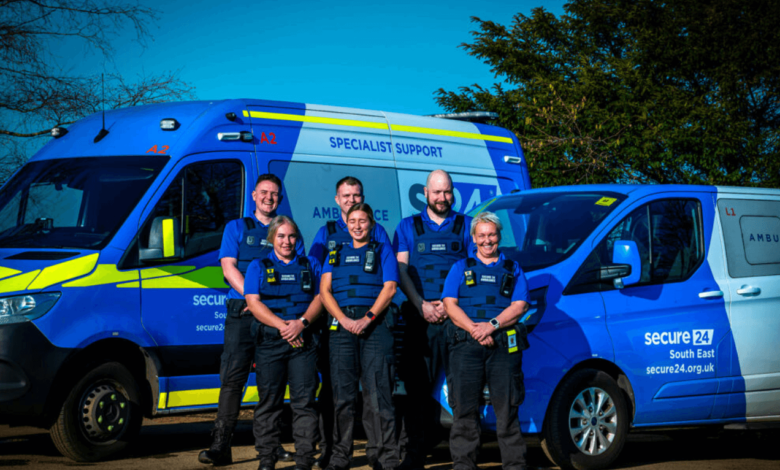How Secure Ambulance Services Are Revolutionizing Mental Health Care in the UK

Mental health care in the United Kingdom has undergone a dramatic transformation in recent years. Among the most significant — and least publicly discussed — innovations is the rise of secure ambulance services. Traditionally, mental health patient transport was handled either by standard ambulances or, in more severe cases, by police vehicles. Both options were problematic: one was ill-equipped for behavioral crises, and the other often escalated distress. Secure ambulance services have changed that dynamic completely. These specialized vehicles bridge the gap between clinical care and public safety, offering compassionate, medically supported, and professionally managed transportation for people experiencing acute mental health episodes. As the UK government and NHS trusts continue to focus on crisis intervention and patient dignity, secure ambulances are becoming an indispensable part of the modern mental health infrastructure.
What Are Secure Ambulance Services?
Secure ambulance services are specialized transport solutions designed to move mental health patients safely and respectfully between care facilities, hospitals, or home environments. Unlike standard ambulances, they are equipped with reinforced interiors, risk-assessment protocols, and trained mental health professionals on board. Their purpose is not only physical safety but also psychological stability — ensuring that patients in crisis are treated with empathy and medical precision rather than restraint and force. These vehicles are often staffed by paramedics and mental health nurses trained in de-escalation, trauma-informed care, and emergency psychiatry. This approach helps prevent confrontations, reduces the need for police involvement, and promotes a more therapeutic journey for vulnerable individuals.
The Historical Problem with Mental Health Transport
Before secure ambulances existed, the transportation of mental health patients was often chaotic and traumatic. Police vehicles were commonly used, especially for Section 136 transfers under the Mental Health Act. Patients were handcuffed, transported in custody vans, and exposed to public shame and fear — experiences that frequently worsened their conditions. Standard NHS ambulances, while medically safe, lacked privacy and mental health expertise. Crew members were trained for physical emergencies, not behavioral health crises. This mismatch led to unsafe transfers, delays in treatment, and widespread criticism from patient advocacy groups. The result was a systemic gap — one that secure ambulance services now fill by combining medical readiness with psychological sensitivity.
How Secure Ambulances Differ from Traditional Transport
The difference between secure ambulances and conventional vehicles lies in both design and philosophy. Secure ambulances have specialized interiors with soft furnishings, non-ligature fixtures, discreet monitoring systems, and calming color schemes to reduce anxiety. Many include separate compartments for staff and patients to maintain safety without confrontation. Staff carry out real-time risk assessments, communicate using trauma-informed techniques, and monitor vital signs throughout the journey. The vehicles are GPS-tracked, fully compliant with NHS safety standards, and often equipped with video recording for transparency. Crucially, these services view patients not as risks to be controlled but as individuals in distress requiring professional support. This human-first mindset has made secure ambulance services an ethical and clinical improvement over older models of mental health transport.
The Role of Secure Ambulance Services in the NHS Framework
Secure ambulances now operate in close partnership with NHS trusts, mental health units, and local authorities. They are increasingly contracted for Section 136 transfers, hospital discharges, and community care transitions. This integration allows NHS staff to focus on clinical treatment rather than logistical crises. Many trusts have reported that outsourcing mental health transport to specialized providers reduces patient incidents and improves satisfaction scores. NHS England’s push for crisis-care reform emphasizes “least restrictive interventions,” and secure ambulance services fit perfectly within that vision. By replacing police vans with purpose-built vehicles, the system upholds patient dignity while enhancing safety — a tangible sign that the UK is prioritizing humane mental health care.
Why Mental Health Professionals Support This Shift
Psychiatrists, nurses, and social workers overwhelmingly support the use of secure ambulances. They recognize that mental health emergencies require more than containment — they demand compassion, structure, and medical competence. Secure ambulance teams are trained to identify early warning signs of psychosis, suicidal ideation, or self-harm, allowing them to respond appropriately without force. This makes patient handovers smoother and reduces the risk of trauma upon arrival at hospitals or crisis units. The collaborative model between ambulance staff and mental health clinicians ensures continuity of care from the moment of pickup to admission, reinforcing the principle that mental health crises are medical emergencies, not criminal situations.
Improving Patient Outcomes and Experiences
One of the most remarkable impacts of secure ambulance services is their effect on patient experience. People transported in these vehicles consistently report feeling safer, more respected, and less stigmatized. The use of calm communication, minimal restraints, and privacy curtains transforms what used to be a frightening ordeal into a controlled, compassionate experience. Moreover, the reduction in police involvement means fewer traumatic associations for patients. For many, the difference between being taken to a hospital in a secure ambulance versus a police car can define how they perceive mental health care for the rest of their lives.
Reducing Pressure on Emergency Services
Secure ambulance services also relieve pressure on overstretched emergency departments and police forces. In the past, officers could spend hours waiting in hospitals to hand over Section 136 patients. Now, dedicated secure transport providers manage the process end-to-end, freeing police to focus on public safety duties. For the NHS, it means fewer staff diverted from frontline medical care to manage behavioral incidents. This efficiency translates into cost savings, shorter response times, and better allocation of clinical resources — all of which improve the overall resilience of the UK healthcare system.
Training and Professional Standards
A cornerstone of secure ambulance services is their investment in specialized staff training. Personnel undergo rigorous preparation in de-escalation tactics, safeguarding, and mental health first aid. Many come from backgrounds in psychiatry, nursing, or social work, which allows for a uniquely holistic approach. Continuous professional development ensures staff remain compliant with NHS frameworks, Care Quality Commission (CQC) standards, and ethical best practices. Training extends beyond emergency response — it emphasizes empathy, communication, and human rights. The result is a professional workforce that balances authority with compassion, ensuring that every patient is treated as a person, not a problem.
Technology and Safety Innovation
Modern secure ambulances leverage cutting-edge technology to maintain both patient and staff safety. Real-time vehicle tracking, in-vehicle communication systems, and encrypted data transfer ensure compliance with privacy regulations. Some services are experimenting with telehealth integration, allowing clinicians to monitor vital signs remotely during transport. Built-in surveillance (used ethically and transparently) helps document incidents for quality assurance. The use of low-stimulus lighting and temperature control also reduces agitation in sensitive patients. These innovations reflect how the sector blends medical science, technology, and empathy — a combination that’s reshaping the UK’s mental health logistics.
Ethical and Legal Considerations
Transporting individuals experiencing mental health crises raises complex ethical questions — about consent, restraint, and dignity. Secure ambulance providers operate under strict legal frameworks aligned with the Mental Health Act 1983, the Human Rights Act 1998, and NHS England’s crisis-care standards. Their emphasis on “least restrictive practice” means that force is only used when absolutely necessary and always proportionately. Documentation, patient feedback, and third-party auditing ensure accountability. This commitment to ethical transparency distinguishes secure ambulance services from older, punitive models and aligns them with modern human-rights-based approaches to healthcare.
Challenges Facing Secure Ambulance Providers
Despite their success, secure ambulance services face ongoing challenges. Funding inconsistencies between local authorities and NHS trusts can delay deployment. Some rural regions still lack adequate coverage. Recruiting and retaining highly trained staff remains difficult given the emotional intensity of the work. There are also public misconceptions — many people still associate “secure transport” with incarceration rather than care. Overcoming these barriers requires continued government support, standardized national commissioning, and public education about the clinical role of these services in mental health care.
Future of Secure Ambulance Services in the UK
The future of secure ambulance services looks promising. With growing recognition from NHS England and the Department of Health, these vehicles are expected to become standard across all mental health pathways. Integration with digital health records, crisis-response hubs, and mobile psychiatric units will further enhance their effectiveness. Policymakers are also exploring hybrid models that combine mental health transport with community outreach and follow-up care. As public awareness grows, secure ambulances could redefine how Britain views and treats mental illness — replacing fear and stigma with professionalism and empathy.
Conclusion
Secure ambulance services represent one of the most humane and innovative developments in British mental health care. By merging medical expertise, compassionate design, and robust safety systems, they provide a dignified alternative to outdated transport methods. Their impact reaches beyond logistics — they symbolize a broader cultural shift toward understanding mental illness as a health issue, not a moral or legal failing. As more NHS trusts adopt this model, the UK moves closer to a mental health system that is not only effective but truly caring.



